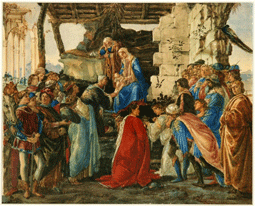'The Adoration of the Magi', after Botticelli
Charles Fairfax Murray (1849-1919). Watercolour and bodycolour on paper, 1873-76.
WorkRuskin noted of this work that it was 'entirely admirable as a picture -- and as a copy' (Works, 30, p. 192).
ArtistCharles Fairfax Murray (1849-1919) made almost 40 copies of Italian masterpieces for the Guild of St George. He was a well-known figure in the late Victorian art world.He began his artistic career by drawing diagrams in a railway engineer's office. In 1866 he became an assistant to Edward Burne-Jones before becoming a designer and painter for the William Morris firm. Ruskin provided Murray with further artistic education and in 1873 sent him to Italy to copy works by Botticelli. After starting a family in Florence, Murray worked in Italy until 1886 when he returned to work in London.In his 'Master's Report: 1884', Ruskin identifies Murray as the 'most skilful' of the artists employed in the task of copying endangered Italian buildings and art. He notes that 'the sketches we possess by his hand, from Carpaccio and Botticelli, are among the principal treasures we can boast at Oxford and Walkley' (Works, 30, p. 72).Despite his skill as a draughtsman, Murray was by the end of his life more famous as an art collector and dealer. Ruskin on BotticelliBotticelli's modern reputation can be traced to Walter Pater's appreciative treatment in The Renaissance: Studies in Art and Poetry (1873). Ruskin's admiration for Botticelli also helped to revive interest. He considered him an artist of 'stupendous power' (Works, 37, p. 138).Ruskin later reflected 'with pride [...] that it was left to me, and to me alone, first to discern, and then to teach [...] the excellency and supremacy of five great painters, despised until I spoke of them, -- Turner, Tintoret, Luini, Botticelli, and Carpaccio.' (Works, 4, p. 355). In Ariadne Florentina (1872), Ruskin gave extensive attention to Botticelli in the separate areas of wood and metal engraving. Collection of the Guild of St George, Museums Sheffield
Ruskin offers some reflections on Botticelli's work and life in 'Aesthetic and Mathematic Schools of Art of Florence (1874)'. 'Of Delineators', he writes, 'the chief is Botticelli': 'Taught by a goldsmith, he learnt by gold-beating and engraving, and is himself a master goldsmith and engraver' (Works, 23, pp. 265-6). He notes that 'Botticelli lived amidst the concourse of Florence, admiring all earthly beauty, himself untainted by it.' (Works, 23, p. 266)After training as a goldsmith, Botticelli received instruction as a painter under one of Ruskin's favourite artists, Filippo Lippi. Ruskin considered this double training the source of Botticelli's singular capacity for design, as well as for colour and light. He believed that Lippi had given Botticelli an education in 'humility', 'love', 'joy' and 'gentleness' (Works, 22, p. 428).Ruskin's greatest admiration for Botticelli's work stemmed from the artist's knowledge of classical literature and of the works of Dante. He found that Botticelli 'understood the thoughts of Heathens and Christians equally and could in a measure paint both Aphrodite and the Madonna [...] So that he is, on the whole, the most universal of painters; and, take him all in all, the greatest Florentine workman.' (Works, 27, p. 372). The word 'workman' recalls the artist's early training as a goldsmith of which Ruskin so approved.
|



















